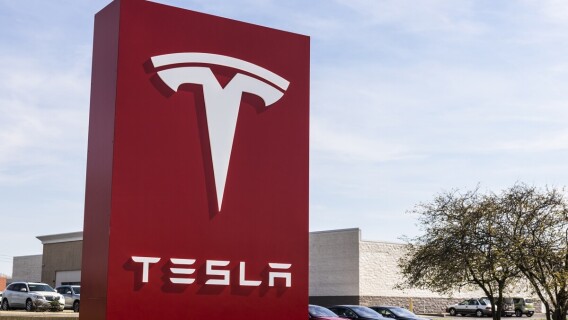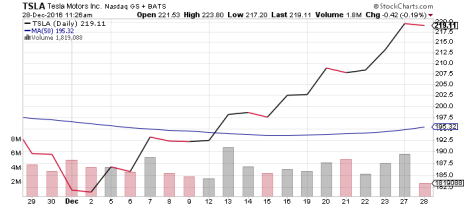There’s no getting around it: 2016 was a down year for Tesla Motors (TSLA). Losses mounted despite strong sales, and Elon Musk’s company got panned for acquiring his other company, SolarCity (SCTY). As a result, TSLA stock tumbled 9%.
But 2017 should be a better year for TSLA. In fact, things are already looking up for the stock.
Investors responded well to a $256 million investment from Panasonic earlier this week for a solar panel manufacturing plant in Buffalo, New York, pushing the stock up a few ticks over the past few trading days. The Panasonic deal will add 1,400 jobs to the Buffalo economy, and is being viewed as a way to appease President-elect Donald Trump after Musk and Trump met earlier this month. The investment will allow Tesla to achieve 1 gigawatt of solar-panel production by 2019.
The Panasonic deal is nice publicity for Tesla Motors, especially the part about adding jobs to the U.S. economy. But I doubt it will be much of a catalyst for the company or the stock, at least in the near term. However, there are several more immediate catalysts for TSLA on the horizon.
Here are three things that should help Tesla stock rebound over the next 12 months:
TSLA Stock Catalyst #1: The Model 3 Launch
Tesla will begin selling its first “affordable” electric car sometime next fall, and the company is already cashing in on consumer excitement over the Model 3. In the first week after the lower-priced sedan (about half the cost of its signature Model S luxury sedan) was unveiled last spring, 373,000 people plopped down the $1,000 deposit fee required to reserve one. Though the company hasn’t updated its Model 3 reservation numbers since, that’s a pretty good indication of consumer demand for Tesla’s cars.
According to the company, it was the “single biggest one-week launch of any product ever,” with more than $14 billion in implied future sales. To put the Model 3 reservation numbers in perspective, no car in the world sold as many units in all of 2015! It was also more than the full-year 2015 sales totals for the BMW 3 Series, Mercedes-Benz C-Class, Acura TLX and Lexus IS combined. Those cars, by the way, are essentially a who’s who of small luxury sedans that are likely to represent the Model 3’s stiffest competition.
Granted, not everyone who slapped down the $1,000 for a Model 3 will end up buying the car, but most will. When you consider that the most Model Ss Tesla has sold in a year were the 50,508 it sold in 2015 (this year’s numbers aren’t out yet) … well, that shows you the potential of the Model 3.
In essence, the Model 3 introduces Tesla to a whole new audience, allowing every “Average Joe” to buy their first electric car. Or at least that’s the perception. And on Wall Street, perception is everything.
TSLA Stock Catalyst #2: Accelerating Sales
The third quarter was a big one for Tesla.
The company beat analyst expectations by a wide margin and produced its second profitable quarter ever, as the company hit record production levels for its Model S and Model X SUV, deliveries rose 70% from the prior quarter, and overall sales increased 145%—the company’s first triple-digit revenue bump since 2013.
Tesla expects similar delivery totals in the fourth quarter, and sales are expected to double again in the first quarter of 2017. And that’s before the Model 3 launch.
TSLA Stock Catalyst #3: The Chart
The full-year and six-month charts for TSLA aren’t pretty. But look at what’s happened to the stock since the start of December.
TSLA topped its 50-day moving average two weeks ago, marking the first time it’s done so since August. The stock has accelerated since, hitting its highest point in four months. If it breaks above 235, which has acted as resistance since the beginning of May, then TSLA may really start to take off.
There could be some consolidation over the next month-plus prior to the company’s fourth-quarter earnings release on February 8. If it beats analyst estimates again, that could trigger another upwards breakout.
Regardless, I think TSLA stock is setting up well for a big recovery in 2017—and beyond.

